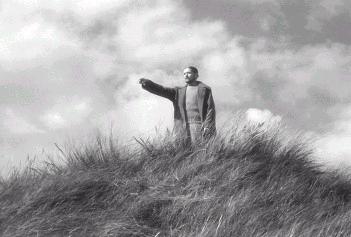奇跡 Ordet カール・T・ドライヤー 126min 1954
正確に記憶しているのでは2度目。スクリーンでは実は初めて。
ビデオでは何度かみた記憶があり、特に出産で亡くなったヒロイン・インガーが再びよみがえる結末などは、忘れようにも忘れられるはずなく、突出した透明感 溢れる構図だけは目に焼き付いていた。しかし、今日改めてスクリーンで見直し、ドライヤーをビデオで見ることの罪深さを実感。あの白の美しさ、カーテンの 白(字幕がまったく読めなくて、苦笑したが)、少女のドレスの白は圧倒的であるし、最初はほとんどコントに思えるが、あの執拗で単調な声がだんだんはまっ てしまう息子ヨハネスの暗い灰色のセーターや、医者、牧師の黒の衣装とのコントラストが、あまりにも美しく統御されていて、愕然としてしまった。黒い衣装 に包まれた男たちの中に生きる白い女性たちの、性=光のコントラストを、網膜に焼き付けることなしに、本当の「奇跡」を見たことにはならない。
処女作「The President」から36年、「裁かるるジャンヌ」から27年であるから円熟期と言っても良いだろうドライヤーの人物のブロッキングも独特であり、あ の亡霊のようにスローな人物の歩みと、繰り返されるヨハネスの「たわ言」、絶望した父親の泣き言の延々と続く円環構造は、独特の歪曲した映画的時空を構成 しており、例えばタルコフスキーの「サクリファイス」の蝋燭の長回しシーンに比べ、その人物たちの異常な単調ぶりが作り出すコントラストにおいて、時空の 歪みがさらに突きつめられている、というべきだろう。
映画は単純でもいい。ゆったりと、確実に、対立する事物、意味、音、光を配置してゆけば、映画は純化され、止揚されてゆくはずだ・・・このような単純な作業理念に従い、音と映像の対位法を研ぎ澄ませていった。それが、小津とドライヤーであろう。
Ordet Carl Theo Dreyer 1954 126min
2nd time to see this Dreyer’s masterpiece. But I realized today that my first viewing on video doesn’t count at all. It is because on VCR you can’t tell the beauty of the Black and White contrast which the film print bears. I’m talking about the WHITENESS of the curtain, the girl’s dress, Inger, the dead heroine’s pajama and the linen of the bed — and the BLACKNESS of the “crazy” Johannes’ gray sweater, dark costumes of the doctor and the paster. In “Ordet” Men-in-Black-and-Women-in-White contrast was stunningly controlled in perfection.
36 years since his first film “The President” and 27 years since “Passion de Jeanne d’Arc”, Dreyer’s mise en scene is sufficiently seductive without overpowering the viewer. The ghost-like slow walk of Johannes, the repetition of his father’s depressed lamentation create never-ending loop of the surreal domestic drama. The time-space relation seemed to be distorted and stretched. When you compare the film with the famous long-walk-with-a-candle scene of Tarkovsky’s “Sacrifice”, “Ordet” ‘s time-space is more distorted and extreme because of the intriguing contrast of the simplest characterization.
Cinema can be very simple. To place the opposing factors -sight and sound- is all you need to do — this is the simplest, yet hardest, working method that Ozu and Dreyer bear in common.
奇跡 Ordet


2008年4月30日
That’s a beautiful description of one of my all time favorite films! Interesting, I first watched it on a crappy VHS print, and later on Criterion DVD. But I have yet to see it on the big screen – I have no idea why I haven’t.
Great point about how the film distorts one’s experience of time and space – and in that sense, the ending, one of the most confounding and moving ever made, is the perfect climax, where time seems to be completely frozen and humans can express themselves in a state of grace.
2008年5月2日
Thanks for your comment, Kevin.
I bet you really want to see it on big screen. I saw Gertrud, which is also my all time favorite as Ordet, the other day on screen and it was essentially different experience from watching on VCR. the same reason. And great description on the climax. thanks.
Atsushi